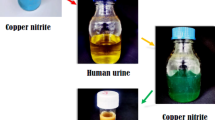Abstract
This work presents a new methodology for preparing silver chloride nanoparticles (AgCl NPs) using human urine. The XRD and EDS results confirmed the formation of AgCl NPs without any other impurities. The FESEM results displayed the formation of clusters of spherical AgCl NPs with multiple Nano-diameters. The study of optical properties corresponds to the behavior of AgCl NPs in the visible region. The results showed that the sample has an energy gap of (Eg) 3.25 eV. Therefore, the author suggests that the results of the current work open a broad horizon for the employment of human urine in various applications.






Similar content being viewed by others
References
Bai J et al (2008) Electrospinning method for the preparation of silver chloride nanoparticles in PVP nanofiber. Appl Surf Sci 254(15):4520–4523
Blume S, Winker M (2011) Three years of operation of the urine diversion system at GTZ headquarters in Germany: user opinions and maintenance challenges. Water Sci Technol 64(3):579–586
Buchanan BJ (2014) Gunpowder studies at ICOHTEC. Icon, pp 56–73
Carrell DT, Peterson CM (2010) Reproductive endocrinology and Infertility, vol 345. Springer, New York
Choi O et al (2008) The inhibitory effects of silver nanoparticles, silver ions, and silver chloride colloids on microbial growth. Water Res 42(12):3066–3074
Cook JD et al (2007) Urine pH: the effects of time and temperature after collection. J Anal Toxicol 31(8):486–496
Dai J et al (2021) Microfluidic sensor integrated with nanochannel liquid conjunct Ag/AgCl reference electrode for trace Pb (II) measurement. Anal Chim Acta 1164:338511
Dio C, Cary E, Foster HB (1961) Roman history. Heinemann
Filella M, Belzile N, Chen Y-W (2013) Human exposure to antimony. III. Contents in some human excreted biofluids (urine, milk, saliva). Crit Rev Environ Sci Technol 43(2):162–214
Garibo D et al (2020) Green synthesis of silver nanoparticles using Lysiloma acapulcensis exhibit high-antimicrobial activity. Sci Rep 10(1):1–11
Grgur BN, Gojgić J, Petrović M (2021) A novel method of preparing the silver chloride cathode for the magnesium seawater activated primary cell. J Power Sources 490:229549
Guyton AC, Hall JE (2006) Textbook of medical physiology. Elsevier Saunders. ISBN 072160240
Hilton SP et al (2020) Life cycle assessment of urine diversion and conversion to fertilizer products at the city scale. Environ Sci Technol 55(1):593–603
Jokanović V, Spasić A, Uskoković D (2004) Designing of nanostructured hollow TiO2 spheres obtained by ultrasonic spray pyrolysis. J Colloid Interface Sci 278(2):342–352
Kang YO et al (2016) Antimicrobial silver chloride nanoparticles stabilized with chitosan oligomer for the healing of burns. Materials 9(4):215
Kashyap M et al (2021) Synthesis, characterization and application of intracellular Ag/AgCl nanohybrids biosynthesized in Scenedesmus sp. as neutral lipid inducer and antibacterial agent. Environ Res 201:111499
Li K et al (2021) An anti-biofilm material: polysaccharides prevent the precipitation reaction of silver ions and chloride ions and lead to the synthesis of nano silver chloride. Nanotechnology 32(31):315601
Mattelaer JJ (1999) Some historical aspects of urinals and urine receptacles. World J Urol 17(3):145–150
Ronco C et al (2017) Critical care nephrology e-book. Elsevier Health Sciences, Amsterdam
Rose C et al (2015) The characterization of feces and urine: a review of the literature to inform advanced treatment technology. Crit Rev Environ Sci Technol 45(17):1827–1879
Saitsu A et al (2021) Low urine pH associated with sarcopenia in the elderly: A multi-center observational study. Medicine 100(21):e26114
Sánchez Huertas C, Villaverde A (2016) Nanophotonic biosensors for deciphering cell regulation pathways. Universitat Autònoma de Barcelona, Barcelona
Sarıgüzel M, Öztürk Y, Günay E (2017) Studying the effect of different glaze compositions on the formation and properties of silver and copper nanoparticles in lustre decoration. J Aust Ceram Soc 53(1):21–28
Scop PM (1965) Band structure of silver chloride and silver bromide. Phys Rev 139(3A):A934
Shahcheraghi SN, Shandiz SAS, Pakpour B (2021) An eco-friendly fabrication of silver chloride nanoparticles (AgCLNPs) using Onopordum acanthium L. extract induces apoptosis in breast cancer MDA-MB-232 cells
Singh R, Choudhary RB (2021) Ag/AgCl sensitized n-type ZnO and p-type PANI composite as an active layer for hybrid solar cell application. Optik 225:165766
Suzuki H et al (1999) Microfabricated liquid junction Ag/AgCl reference electrode and its application to a one-chip potentiometric sensor. Anal Chem 71(22):5069–5075
Tao S et al (2018) Continuous synthesis of Ag/AgCl/ZnO composites using flow chemistry and photocatalytic application. Ind Eng Chem Res 57(9):3263–3273
Trinh ND, Nguyen TTB, Nguyen TH (2015) Preparation and characterization of silver chloride nanoparticles as an antibacterial agent. Adv Nat Sci Nanosci Nanotechnol 6(4):045011
Urakaev FK et al (2020) Synthesis and photocatalytic properties of silver chloride/silver composite colloidal particles. Colloid J 82(1):76–80
Urnovitz HB et al (1999) Urine antibody tests: new insights into the dynamics of HIV-1 infection. Oxford University Press, Oxford
Xu K et al (2021) Preparation and performance of a solid-state thin-film Ag/AgCl quasi-reference electrode modified by chitosan-graphene. Mater Technol 36(2):63–71
Yang PJ et al (2014) Duration of urination does not change with body size. Proc Natl Acad Sci 111(33):11932–11937
Yang L et al (2016) An in-situ synthesis of Ag/AgCl/TiO2/hierarchical porous magnesian material and its photocatalytic performance. Sci Rep 6(1):1–7
Acknowledgements
The authors would like to thank Al-Esraa University College, Baghdad, Iraq for its support in the present work.
Author information
Authors and Affiliations
Corresponding author
Ethics declarations
Conflict of interest
The authors declare that they have no conflict of interest.
Additional information
Publisher's Note
Springer Nature remains neutral with regard to jurisdictional claims in published maps and institutional affiliations.
Rights and permissions
About this article
Cite this article
Rahmah, M.I. Preparation of silver chloride nanoparticles using human urine. Appl Nanosci 11, 2611–2615 (2021). https://doi.org/10.1007/s13204-021-02133-7
Received:
Accepted:
Published:
Issue Date:
DOI: https://doi.org/10.1007/s13204-021-02133-7




